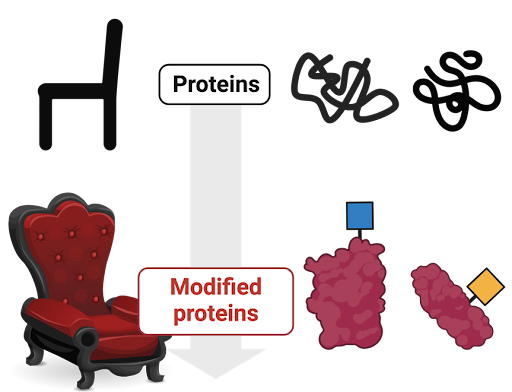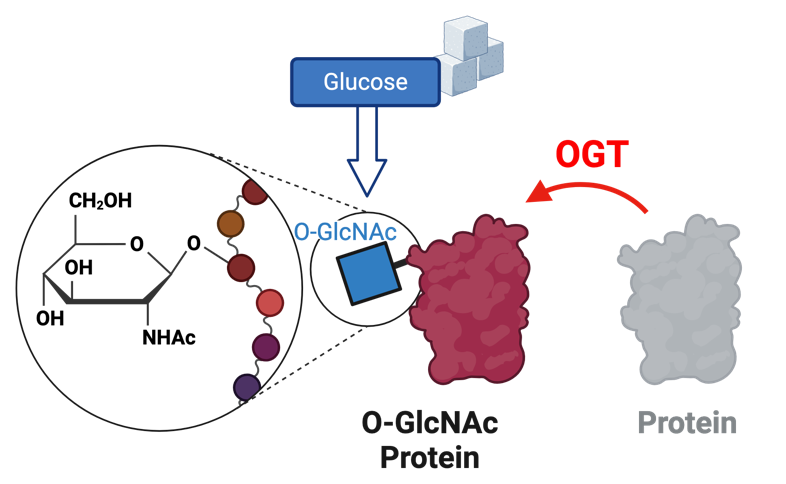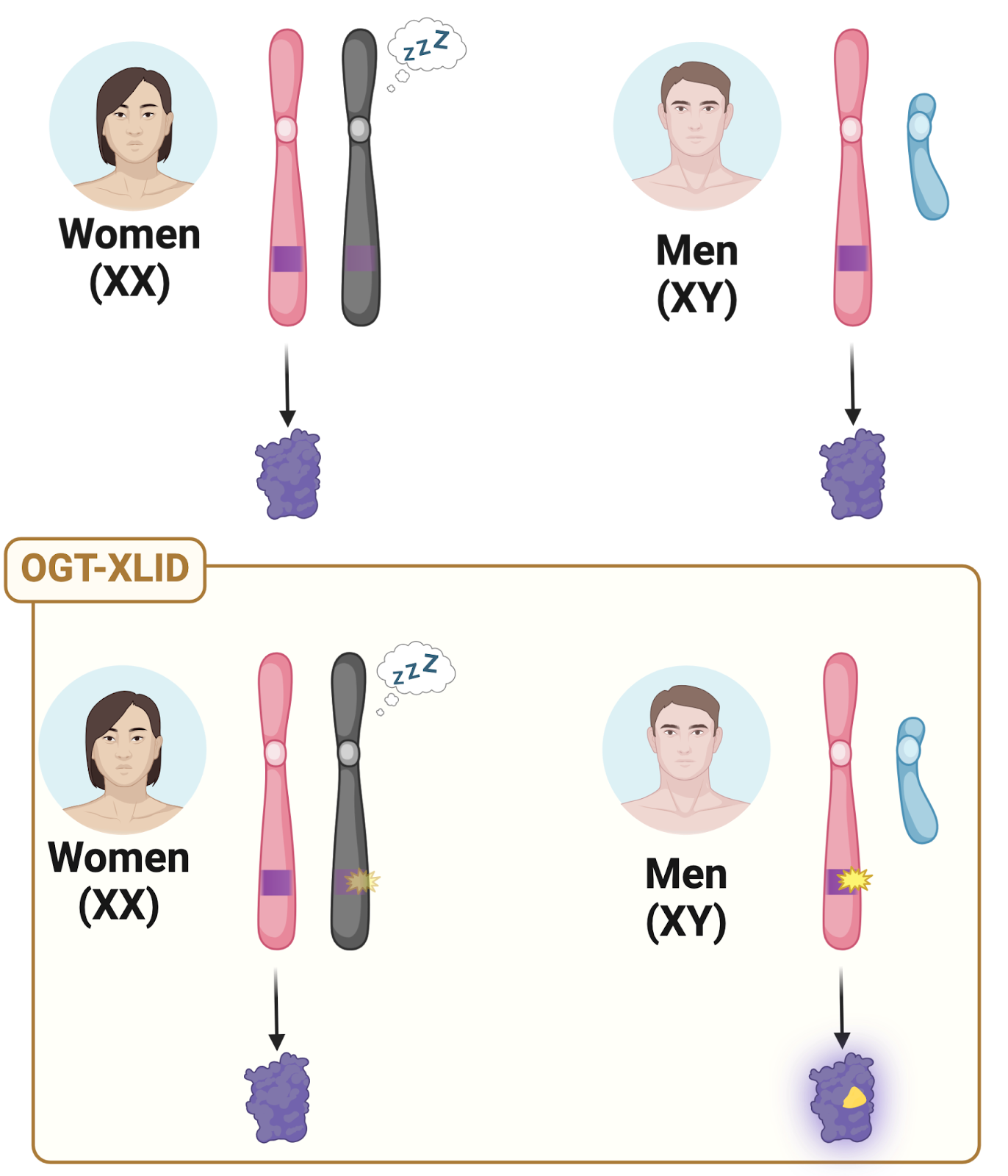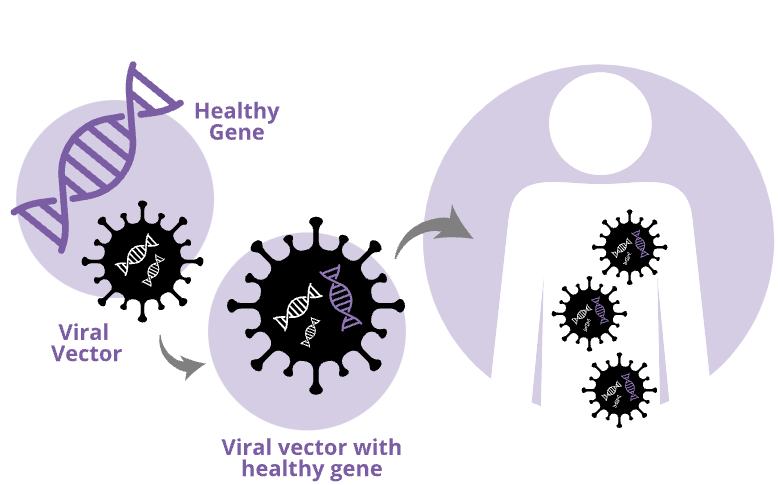About OGT
What is OGT?

Figure credit: Stephanie Olivier-Van Stichelen (Made on Biorender).
OGT-XLID (O-GlcNAc Transferase X-Linked Intellectual Disability), also known as OGT-CDG is a rare disease resulting from a mutation in the OGT gene.
Think of your body as a factory that builds many different products. In this factory, genes are like blueprints or instructions for making proteins, like the products being built.
If the blueprints contain a mistake or typo, the final chair might have a wobbly leg or an awkward shape. This mistake in the blueprint is similar to a gene mutation. In OGT-CDG patients, the mutations are found in the OGT gene, resulting in an improper O-GlcNAc Transferase (OGT) protein.
The OGT gene encodes for the enzyme O-GlcNAc Transferase that is essential for life in humans and most multicellular organisms. O-GlcNAc Transferase is responsible for adding a single sugar, O-GlcNAc, onto target proteins in a process known as O-GlcNAcylation. O-GlcNAcylation is involved in a number of important biological processes including diabetes, cancer, neurodegeneration, and neural development. There have been reported mutations in the OGT gene that have been found to cause OGT X-Linked Intellectual Disability, with all affected presenting with intellectual disability (IQ <70) and developmental delay.
What does CDG stand for?
OGT-XLID is part of a larger group of diseases called Congenital Disorders of Glycosylation (CDG). All the mutations in this group of diseases involve genes that impact the modification of proteins by sugars. This process, called glycosylation, is essential for maintaining healthy, functioning cells (see below). Over 700 genes, including OGT, contribute to protein glycosylation; a mutation in any of these can result in CDG.
Consequences of OGT mutations?
Mutations of OGT directly impact our bodies’ ability to modify proteins with sugars. But why does our body need to modify proteins with sugars?
Let’s come back to the pieces of furniture, e.g., proteins, in our factory body. When you first finish building them, they might be pretty basic. To make it more functional or stylish, you might need to add extra touches, like paint or decorative knobs, making them ready to fill their final purpose. This additional work on the product after the initial assembly is similar to what happens with proteins in your body. Extra touches on your proteins include adding small groups, such as sugar molecules (also called carbohydrates), allowing them to correctly do their work in the body.
Our body has roughly 25,000 different proteins that perform nearly 5 billion different functions every day. Modifying proteins can change their function and allow them to serve multiple purposes within our body. Currently, over 50% of human proteins are modified with carbohydrates (e.g., glycosylated)
O-GlcNAc transferase (OGT) is responsible for adding a specific sugar called GlcNAc onto over 9,000 proteins.
Our body produces GlcNAc from the glucose we ingest, which is reflected in our blood sugar. Thus, O-GlcNAc proteins reflect the level of glucose surrounding our organs.

Figure credit: Stephanie Olivier-Van Stichelen (Made on Biorender).

Figure credit: Adam Knier (Olivier-Van Stichelen lab). Made on Biorender.

Figure credit: THE HUMAN PROTEIN ATLAS

Figure credit: Stephanie Olivier-Van Stichelen (Made on Biorender)
Where is OGT present in the human body?
OGT is found in every organ, but it is especially abundant in the brain, which is one of the organs that craves sugar the most.
OGT generates O-GlcNAc proteins that are also found throughout the body and are workers in our body, each with a specific job:
Builders: Some proteins build and maintain our body, making your skin, hair, and nails strong and flexible.
Chefs: Other proteins act like chefs in a kitchen, speeding up important chemical reactions. These “chefs” help break down food so your body can use it, or help in other vital processes like cleaning up waste.
Managers: Some proteins act like managers who oversee various operations. They help control processes in your body, like making sure your blood sugar levels stay balanced or regulating cell growth.
Communicators: Lastly, some proteins are like communication systems, sending and receiving messages between different parts of your body to make sure everything works together smoothly.
Gender differences in OGT-XLID?
Genes are located on chromosomes, which are different in males and females. Indeed, humans have two sex chromosomes—X and Y. Women typically have two X chromosomes (XX), while men have one X and one Y chromosome (XY).
Genes found on the X chromosome are called X-linked genes. Because women have two X chromosomes, they have two “copies” of these X-linked genes, while men have only one X chromosome. OGT is one of these genes.
Remember, genes produce proteins. If both X chromosomes in women were fully active, there would be a double dose of the genes on the X chromosomes compared to men. To prevent this imbalance, one of the X chromosomes in each cell of a woman’s body is randomly turned off, “sleeping” or inactivated.
When a gene on the X chromosome is defective or mutated, it can lead to genetic disorders that are “skewed” toward males. In women, having two X chromosomes means that if one X-linked gene is faulty, the other X chromosome might still have a working copy of the gene. However, in men, having only one X chromosome means that if that single X-linked gene is defective, there isn’t a second X chromosome to compensate, and you have defective proteins produced, which is the case in OGT-CDG.

Figure credit: Stephanie Olivier-Van Stichelen (Made on Biorender).
Treatment options

1. Supplements
Sugar molecules, found on and in every cell (human, bacteria, etc.), play crucial roles in cell signaling, protein modification, and various biological processes.
N-acetylglucosamine (GlcNAc) is a sugar molecule that is added to proteins to regulate their function in the cell. O-GlcNAcylation can affect the activity, stability, and localization of proteins. Dysregulation of O-GlcNAcylation has been implicated in the pathogenesis of several diseases.
GlcN (glucosamine)
GlcN is a sugar molecule that is the precursor of GlcNAc.
Because there is not a safety concern with GlcNAc, GlcN is available for diet supplementation.

Figure credit: AskBio
2. Gene Therapy
Gene therapy is a promising therapeutic approach for treating OGT-XLIS. This technique involves using gene editing technologies to correct the mutated OGT gene and restore its normal function. The corrected gene can then be delivered to the brain using various methods, such as viral vectors or nanoparticles.
Gene editing technologies
There are several different gene editing technologies that can be used to correct the OGT gene. These technologies include:
- Adeno-associated virus (AAV): AAV is transformed from a naturally occurring virus into a delivery mechanism for gene therapy. The viral DNA is replaced with new DNA, and it becomes a precisely coded vector and is no longer considered a virus, as most of the viral components have been replaced. The AAV vector is then used to deliver normal copies of genes to the right tissues or organs in the body, but it now delivers the therapy that has been engineered into it.
- CRISPR/Cas9: This is a revolutionary gene editing technology that uses a Cas9 enzyme to cut DNA at specific locations. The Cas9 enzyme is guided to the correct location by a short RNA molecule called a guide RNA. Once the DNA is cut, the cell’s natural repair mechanisms can be used to insert or delete DNA sequences.
- TALENs: These are engineered proteins that can also be used to cut DNA at specific locations. TALENs are designed by fusing a DNA-binding domain to a nuclease enzyme. The DNA-binding domain is responsible for targeting the TALEN to the correct location in the genome, while the nuclease enzyme is responsible for cutting the DNA.
- Zinc finger nucleases (ZFNs): These are another type of engineered protein that can be used to cut DNA at specific locations. ZFNs are designed by fusing zinc finger domains to a nuclease enzyme. The zinc finger domains are responsible for targeting the ZFN to the correct location in the genome, while the nuclease enzyme is responsible for cutting the DNA.
Delivery of the corrected gene to the brain
Once the OGT gene has been corrected, it needs to be delivered to the brain. This can be done using a variety of methods, including:
- Viral vectors: These are viruses that have been engineered to carry and deliver genes to cells. Viral vectors are very efficient at delivering genes to cells, but they can also trigger an immune response.
- Nanoparticles: These are small particles that can be used to carry and deliver genes to cells. Nanoparticles are less efficient at delivering genes to cells than viral vectors, but they are less likely to trigger an immune response.
Challenges
There are several challenges that need to be overcome before gene therapy can be used to treat OGT-XLID. These challenges include:
- Developing safe and effective gene editing tools: The gene editing tools that are currently available can sometimes cause unintended mutations in the genome. This could lead to serious side effects.
- Developing efficient methods for delivering the corrected gene to the brain: The methods that are currently available for delivering genes to the brain are not very efficient. This means that a large amount of the corrected gene would need to be delivered to the brain in order to be effective.
- Ensuring that the corrected gene functions correctly in the brain: Even if the corrected gene is delivered to the brain, there is no guarantee that it will function correctly. This is because the brain is a complex organ and it is difficult to control the expression of genes in the brain.

3. OGA inhibitors
OGA inhibitors are a class of drugs that target the enzyme O-GlcNAcase (OGA). OGA plays a crucial role in regulating O-GlcNAcylation, a post-translational modification that involves the addition of a sugar molecule (O-GlcNAc) to proteins. Dysregulation of O-GlcNAcylation is implicated in the pathogenesis of various diseases, including cancer, neurodegenerative diseases, and metabolic disorders.
Current use of OGA inhibitors
OGA inhibitors are currently being investigated as potential therapeutic agents for a variety of diseases. However, they are not yet approved for any clinical use. Some of the diseases that OGA inhibitors are being investigated for include:
- Cancer: OGA inhibitors have been shown to inhibit the growth of cancer cells in preclinical studies. This is because OGA inhibitors can increase O-GlcNAcylation levels, which can lead to the activation of tumor suppressor genes and the inhibition of oncogenes.
- Neurodegenerative diseases: OGA inhibitors have been shown to protect neurons from damage in preclinical studies of Alzheimer’s disease, and Parkinson’s disease. This is because OGA inhibitors can increase O-GlcNAcylation levels, which can improve protein folding and prevent protein aggregation.
- Metabolic disorders: OGA inhibitors have been shown to improve insulin sensitivity and glucose tolerance in preclinical studies of type 2 diabetes. This is because OGA inhibitors can increase O-GlcNAcylation levels, which can improve insulin signaling.
Potential use of OGA inhibitors for OGT-gene-based disorders
OGA inhibitors may also have potential as a treatment for OGT-gene-based disorders. OGT-gene-based disorders are a group of genetic disorders that are caused by mutations in the OGT gene. These mutations lead to a deficiency of OGT protein, which results in decreased O-GlcNAcylation levels. Dysregulation of O-GlcNAcylation is thought to contribute to the pathogenesis of OGT-gene-based disorders.
OGA inhibitors could potentially be used to treat OGT-gene-based disorders by increasing O-GlcNAcylation levels. This could help to restore normal protein function and alleviate symptoms of the disease.
Challenges
There are several challenges that need to be overcome before OGA inhibitors can be used to treat OGT-gene-based disorders. These challenges include:
- Developing OGA inhibitors that are specific to OGA: The OGA enzyme is similar to other enzymes, so it can be difficult to develop OGA inhibitors that do not also inhibit other enzymes. This could lead to unwanted side effects.
- Developing OGA inhibitors that can cross the blood-brain barrier: The blood-brain barrier is a barrier that protects the brain from toxins and other harmful substances. However, it can also make it difficult to deliver drugs to the brain. OGA inhibitors would need to be able to cross the blood-brain barrier in order to be effective in treating OGT-gene-based disorders.
- Determining the optimal dose of OGA inhibitors: Too low a dose of an OGA inhibitor may not be effective, while too high a dose could cause side effects.
Despite these challenges, OGA inhibitors are a promising therapeutic approach for OGT-gene-based disorders. With continued research, it is possible that OGA inhibitors will one day be used to treat these disorders.
Glossary
Chromosome
A chromosome is a long, thread-like structure made of DNA and proteins found in every cell. It carries genetic information in the form of genes, which determine our traits and functions. Humans have 23 pairs of chromosomes, making a total of 46, with one set coming from each parent.
Mutation
A change in the DNA that can alter how a gene works and might cause health problems.
X-inactivation
X-inactivation is a process that happens in females, where one of the two X chromosomes in each cell gets turned off or "shut down." This helps balance the amount of X-linked genes between males and females.
Glycosylation
A process where sugars are added to proteins, affecting how they work and where they go in the cell.
Congenital Disorders of Glycosylation (CDG)
A group of rare diseases caused by problems with the sugar-adding process to proteins, leading to various health issues.
Gene
A part of DNA that provides instructions for making proteins and determining traits.
X-linked genes
X-linked genes are genes located on the X chromosome, one of the two sex chromosomes.
Protein
A big molecule made from amino acids that helps build and repair tissues, and supports many functions in the body.
O-GlcNAc Transferase (OGT)
An enzyme that adds a specific sugar to proteins, helping regulate their functions in the cell.
Enzyme
A biological catalyst and is almost always a protein. It speeds up the rate of a specific chemical reaction in the cell.
Gene Variant
Also known as a genetic variant, is a specific alteration or change in the DNA sequence of a gene when compared to a reference or wild-type sequence. These variations can occur naturally as a result of genetic mutations, and they can lead to differences in the function, expression, or regulation of the gene.
Credits:
- Olivier-Van Stichelen laboratory https://www.ovsoglcnaclab.com
- Lance Well’s laboratory: Naomi Lee Hitefield Garwood, Johnathan Martin Mayfield, Laura Katherine Holden
